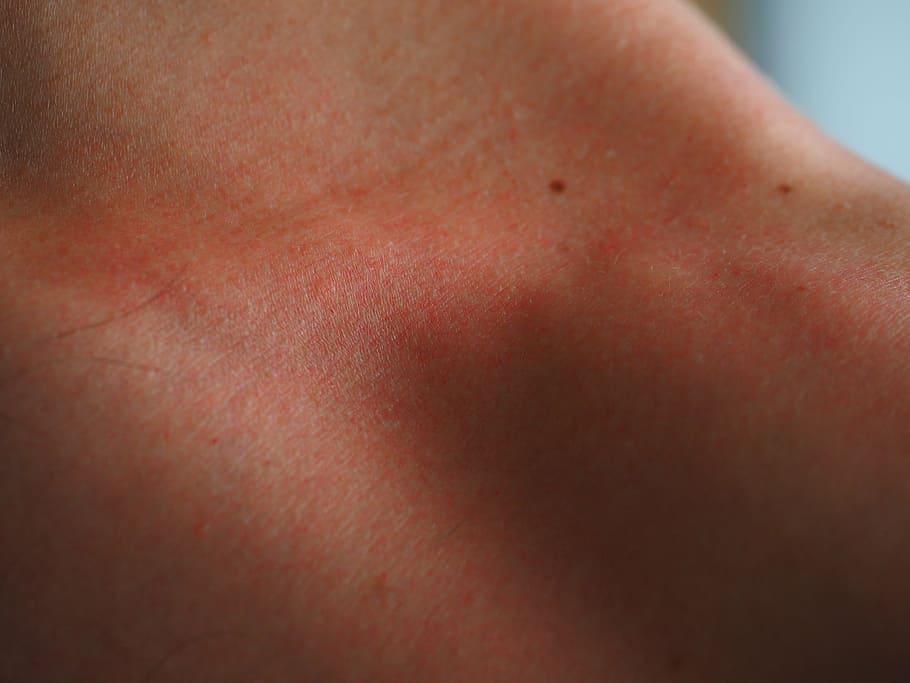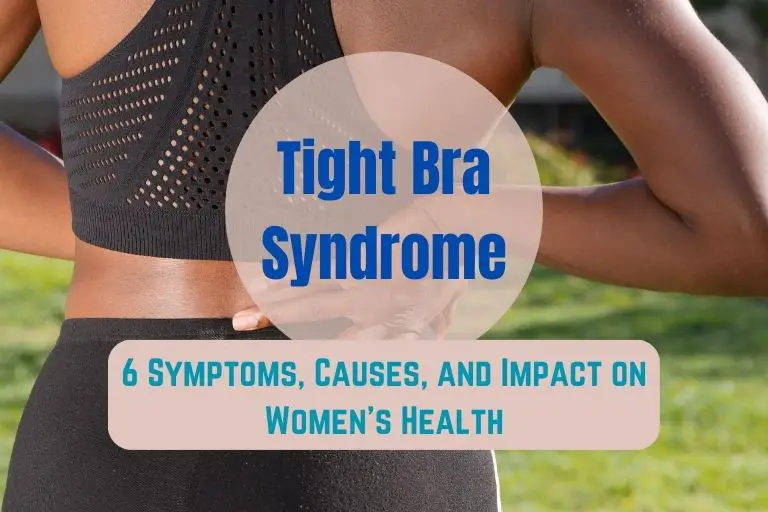In the realm of fashion, undergarments have long played a crucial role in enhancing comfort, support, and aesthetic appeal. Among these essential pieces, the bra stands as a cornerstone of women’s intimate apparel. However, beneath the allure and functionality lies a phenomenon known as “Tight Bra Syndrome.”
This condition has garnered attention for its potential impact on women’s health, highlighting the importance of understanding and addressing the consequences of wearing bras that are excessively tight or ill-fitting.
In this essay, I will delve into the concept of Tight Bra Syndrome, exploring its symptoms, causes, and the potential implications it holds for women’s physical well-being. By shedding light on this often overlooked issue, we aim to raise awareness and promote healthier practices in the realm of women’s undergarments.
The Tight Bra Syndrome, its Causes, and the Potential Implications for Women’s Health
“Tight Bra Syndrome” is not a recognized medical term within the mainstream medical community. However, there are discussions and claims about the potential effects of wearing tight bras on women’s health. It’s important to note that scientific research on this topic is limited and inconclusive. Here’s a general overview of the concept and the potential implications:
1. Concept of Tight Bra Syndrome:
“Tight Bra Syndrome” is a term used informally to describe the discomfort, pain, or potential health effects that some women may experience due to wearing bras that are too tight or constrictive. Proponents of this idea suggest that tight bras could impede lymphatic flow, and blood circulation, and cause various health issues.
2. Causes and Claims:
The following are some of the claims associated with “Tight Bra Syndrome,” although scientific evidence to support these claims is limited:
- Lymphatic Flow: Some proponents suggest that tight bras could restrict the flow of lymphatic fluid, leading to toxin buildup and potentially contributing to the development of breast-related health problems.
- Circulation: It is also proposed that tight bras may restrict blood circulation, potentially causing discomfort, and pain, or even contributing to breast-related health issues.
- Breast Health: Claims have been made that tight bra could impact breast tissue health, potentially leading to issues such as fibrocystic breasts or even an increased risk of breast cancer.
3. Potential Implications for Women’s Health:
While some women do report discomfort from wearing tight bras, scientific evidence supporting the concept of “Tight Bra Syndrome” and its potential implications for women’s health is lacking. Many medical professionals consider the claims associated with this concept to be anecdotal and not supported by rigorous research. Here are a few key points to consider:
- Lymphatic System: The lymphatic system plays a vital role in immune function and fluid balance. While there is a theoretical concern that tight clothing could potentially impede lymphatic flow, there is no substantial scientific evidence linking tight bras to lymphatic dysfunction.
- Circulation: Tight bras might cause temporary discomfort or marks on the skin, but there’s little evidence to suggest that they significantly impact blood circulation to the extent that it would pose a serious health risk.
- Breast Health: Research on the link between bra-wearing habits and breast health, including the risk of breast cancer, has not established a consistent or significant association. Factors such as genetics, hormonal influences, and lifestyle choices are likely to play more significant roles in breast health.
6 Symptoms of Tight Bra Syndrome
Tight Bra Syndrome is a condition characterized by the discomfort and health issues that arise from wearing bras that are excessively tight or ill-fitting. The symptoms of Tight Bra Syndrome can vary from person to person but commonly include:
1. Shoulder and Neck Pain:

Shoulder and neck pain are commonly reported symptoms of Tight Bra Syndrome. When the bra straps are excessively tight or poorly adjusted, they can dig into the shoulders, leading to discomfort and pain. The constant pressure and friction on the shoulder area can cause muscle tension, strain, and even headaches.
The tightness of the bra can also contribute to poor posture, as the body tries to compensate for the constriction. As a result, the muscles in the neck and upper back may become overworked and strained, leading to further pain and discomfort.
Proper bra fitting and adjusting the straps to ensure a comfortable fit can help alleviate shoulder and neck pain associated with Tight Bra Syndrome. Straps that are too tight or dig into the shoulders can cause pain and discomfort in the shoulder and neck area.
2. Restricted Breathing:

Restricted breathing is another significant symptom of Tight Bra Syndrome. When a bra is excessively tight, particularly around the ribcage, it can limit the expansion of the chest and diaphragm. This restriction can make it challenging to take deep breaths and may lead to a sensation of breathlessness or shallow breathing.
The constrictive nature of a tight bra can affect the natural movement of the ribcage during breathing, potentially causing discomfort and difficulty in obtaining sufficient oxygen. Proper bra fitting, choosing bras with adjustable bands, or opting for wire-free styles can help alleviate the restriction and improve breathing comfort for individuals experiencing this symptom.
If breathing difficulties persist or worsen, it is essential to seek medical advice to rule out any underlying respiratory issues. A tight bra can constrict the ribcage and limit the expansion of the chest, making it difficult to take deep breaths and potentially causing shortness of breath.
3. Headaches:

Headaches can be a notable symptom of Tight Bra Syndrome. The tension and pressure created by a tight bra can contribute to the onset of frequent headaches. The straps and bands of a bra that are excessively tight or ill-fitting can exert pressure on the neck, shoulders, and scalp, leading to muscle tension and discomfort.
This tension can radiate upwards and result in headaches. Additionally, the constriction of blood vessels and restricted blood flow caused by a tight bra can contribute to headaches as well. Ensuring proper bra fitting, choosing bras with adjustable straps, and opting for wire-free or softer materials can help alleviate the tension and reduce the likelihood of experiencing headaches associated with Tight Bra Syndrome.
If headaches persist or worsen, it is advisable to consult with a healthcare professional to rule out any underlying causes or to explore alternative management strategies.
4. Skin Irritation:

Skin irritation is a common symptom associated with Tight Bra Syndrome. Wearing a bra that is too tight can cause constant friction between the bra and the skin, particularly in areas where the bra rubs against the body. This friction can result in skin irritation, redness, and even rashes.
The skin may become sensitive and develop discomfort due to the prolonged pressure and lack of breathability caused by a tight bra. Additionally, the presence of moisture trapped between the skin and the bra can further contribute to skin irritation and potential bacterial or fungal infections.
Opting for properly fitting bras made from breathable and soft materials, as well as taking breaks from wearing bras when possible, can help alleviate skin irritation and promote skin health for individuals experiencing this symptom.
If skin irritation persists or worsens, it is recommended to seek medical advice for appropriate evaluation and treatment.
5. Poor Circulation:

Poor circulation is a notable symptom that can occur in individuals with Tight Bra Syndrome. Wearing a bra that is excessively tight can impede blood flow, particularly in the areas where the bra exerts the most pressure.
The constriction of blood vessels can hinder the circulation of oxygenated blood, resulting in reduced circulation to the surrounding tissues. This can manifest as numbness or tingling sensations in the arms or fingers.
The lack of proper blood flow can also lead to a sensation of coldness or even a bluish discoloration in the affected areas. Choosing bras with proper sizing, and adjustable bands, and avoiding excessively tight bras can help alleviate the restriction and promote healthy circulation.
If poor circulation symptoms persist or worsen, it is crucial to consult a healthcare professional for evaluation and guidance.
6. Breast Discomfort:

Wearing a tight bra can cause breast pain, tenderness, or even inflammation. The pressure and constriction on the breast tissue can result in discomfort and sensitivity. Breast discomfort is a significant symptom associated with Tight Bra Syndrome. Wearing a bra that is too tight or constricting can cause discomfort and pain in the breast area.
Excessive pressure on the breast tissue from the bra can lead to soreness, tenderness, or even inflammation. The discomfort may be felt throughout the breasts or localized in specific areas. Additionally, the tightness of the bra can interfere with the natural movement of the breasts, causing further discomfort during physical activities or prolonged wear.
Opting for bras that provide proper support without excessive constriction, ensuring the correct bra size, and choosing wire-free or softer materials can help alleviate breast discomfort and promote overall breast health. If breast discomfort persists or is accompanied by other concerning symptoms, it is advisable to seek medical evaluation to rule out any underlying conditions.
It is important to note that while these symptoms are commonly associated with Tight Bra Syndrome, they can also be indicative of other underlying health issues. If you are experiencing persistent or severe symptoms, it is recommended to consult with a healthcare professional for an accurate diagnosis and appropriate treatment.
The Potential Implications of Tight Bra Syndrome
The potential implications of Tight Bra Syndrome can have a significant impact on women’s physical well-being. While further research is needed to establish a clear causal relationship between tight bras and specific health conditions, anecdotal evidence and personal accounts suggest several potential implications:
Chronic pain and discomfort:
Prolonged wear of tight bras can lead to chronic pain and discomfort, particularly in the shoulders, neck, and back. This can interfere with daily activities and reduce overall quality of life.
Postural issues:
Tight bras can force the body into an unnatural position, leading to poor posture. Over time, this can result in spinal misalignment, muscle imbalances, and related musculoskeletal issues.
Breathing difficulties:
Excessive constriction from tight bras can restrict the expansion of the ribcage, making it difficult for women to take deep breaths. This can lead to shallow breathing and potential respiratory issues.
Lymphatic flow disruption:
The lymphatic system plays a vital role in removing waste products and toxins from the body. Tight bras can impede lymphatic circulation, potentially leading to lymphatic congestion and contributing to the development of breast-related conditions, such as lymphedema or cyst formation.
Skin problems:
Constant friction between a tight bra and the skin can cause skin irritation, redness, and rashes. The skin may become more susceptible to chafing, moisture buildup, and bacterial or fungal infections.
Breast discomfort:
Tight bras can exert pressure on breast tissues, leading to breast pain, tenderness, and inflammation. This can cause discomfort and affect a woman’s overall breast health.
Note:
It is important to note that while these potential implications have been reported anecdotally, more scientific research is needed to establish a clear cause-and-effect relationship between tight bras and specific health conditions.
Nonetheless, the discomfort and potential consequences associated with Tight Bra Syndrome highlight the importance of wearing properly fitted bras that provide adequate support without excessive constriction.
Prioritizing comfort, proper bra fitting, and being aware of any signs of discomfort can help minimize the potential implications of Tight Bra Syndrome on women’s physical well-being.

Prevention and Management of Tight Bra Syndrome
Prevention and management strategies for Tight Bra Syndrome involve taking proactive steps to ensure proper bra fitting and prioritizing comfort and well-being. Here are some key approaches:
Get Professional Bra Fittings:
Consult with a professional bra fitter to determine the correct bra size and style that suits your body shape and provides optimal support. Regular bra fittings are recommended, especially during periods of weight fluctuations, hormonal changes, or post-pregnancy.
Choose the Right Bra Style and Size:
Select bras with adjustable straps and bands that fit snugly without excessive tightness. Ensure the bra cups fully encompass the breasts, providing adequate coverage and support.
Opt for Wire-free or Softer Materials:
Consider wearing wire-free bras or those with softer, more flexible underwires to minimize constriction and improve comfort. Choose bras made from breathable and gentle materials that reduce friction and irritation.
Take Breaks from Wearing Bras:
Whenever possible, allow your body to have breaks from wearing bras, especially during sleep or periods of rest. This allows the breast tissues to relax and promotes better circulation.
Engage in Exercises and Stretches:
Regularly perform exercises and stretches that focus on strengthening the chest, back, and shoulder muscles. This can help alleviate tension, improve posture, and reduce discomfort associated with tight bras.
Listen to Your Body:
Pay attention to any signs of discomfort, pain, or skin irritation caused by a bra. If you experience persistent symptoms, consider trying different bra styles, and sizes, or consulting with a healthcare professional for further evaluation.
Stay Informed and Educate Others:
Stay updated on the latest information regarding bra fitting, breast health, and the potential risks of tight bras. Share this knowledge with friends, family, and peers to promote awareness and encourage healthier practices.
Remember that each individual is unique, and finding the right solutions may require some trial and error. It is essential to prioritize your comfort, well-being, and breast health when selecting and wearing bras.
By adopting preventive measures and proactive management strategies, you can minimize the potential risks associated with Tight Bra Syndrome and ensure a comfortable and supportive experience.
Most Related Topics You Should Read
18 Side Effects of Wearing Tight Bras – How To Fix Problems
13 Side Effects Of Not Wearing a Bra With The Best Solutions
The 13 Disadvantages of Not Wearing a Bra – You Must Know Before Go Braless
How to Not Wear a Bra With Large Breasts – 15 Great Hacks To Hide Large Breasts
21 Painless Bra Alternatives for Large Bust – Francisco Costa’s and Melisa Goldie’s Opinions
Tight Bra Syndrome: Everything You Need to Know
Frequently Asked Questions
Q: What is Tight Bra Syndrome?
A: Tight Bra Syndrome refers to the discomfort and health issues experienced by women due to wearing bras that are excessively tight or ill-fitting.
Q: What are the symptoms of Tight Bra Syndrome?
A: The symptoms can include shoulder and neck pain, restricted breathing, headaches, skin irritation, poor circulation, and breast discomfort.
Q: What causes Tight Bra Syndrome?
A: Tight Bra Syndrome is primarily caused by wearing bras that do not fit properly, including incorrect bra size, misconceptions about bra fitting, and the use of underwire bras.
Q: What are the potential implications of Tight Bra Syndrome for women’s health?
A: The potential implications can include chronic pain and discomfort, postural issues, breathing difficulties, skin problems, and potential effects on breast health.
Q: How can I prevent Tight Bra Syndrome?
A: To prevent Tight Bra Syndrome, it is important to prioritize proper bra fitting, choose bras with adjustable straps and soft materials, and listen to your body for any signs of discomfort or pain.
Q: How can I manage Tight Bra Syndrome if I already experience symptoms?
A: Managing Tight Bra Syndrome involves ensuring proper bra fitting, opting for more comfortable bra styles, taking breaks from wearing bras, engaging in exercises and stretches to alleviate tension, and seeking professional guidance if symptoms persist or worsen.
Final Opinion
Tight Bra Syndrome highlights the importance of considering the impact of fashion choices on women’s health. While scientific evidence is still emerging, anecdotal experiences and personal accounts emphasize the need to prioritize comfort and proper bra fitting to prevent potential health issues.
By understanding the symptoms, causes, and effects of Tight Bra Syndrome, women can make informed decisions about their undergarments and take proactive steps toward their well-being. Furthermore, further research and awareness campaigns are necessary to delve deeper into the potential health consequences and promote healthier practices in the fashion industry.
Useful Link – 5 Signs Your Bra Is Definitely Too Tight – and How to Find Your Perfect Size

